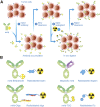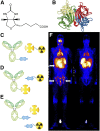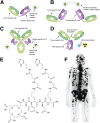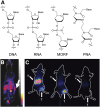Pretargeted Imaging and Therapy
- PMID: 28687600
- PMCID: PMC5632733
- DOI: 10.2967/jnumed.117.189944
Pretargeted Imaging and Therapy
Abstract
In vivo pretargeting stands as a promising approach to harnessing the exquisite tumor-targeting properties of antibodies for nuclear imaging and therapy while simultaneously skirting their pharmacokinetic limitations. The core premise of pretargeting lies in administering the targeting vector and radioisotope separately and having the 2 components combine within the body. In this manner, pretargeting strategies decrease the circulation time of the radioactivity, reduce the uptake of the radionuclide in healthy nontarget tissues, and facilitate the use of short-lived radionuclides that would otherwise be incompatible with antibody-based vectors. In this short review, we seek to provide a brief yet informative survey of the 4 preeminent mechanistic approaches to pretargeting, strategies predicated on streptavidin and biotin, bispecific antibodies, complementary oligonucleotides, and bioorthogonal click chemistry.
Keywords: biotin; bispecific antibody; click chemistry; multistep targeting; pretargeting; streptavidin.
© 2017 by the Society of Nuclear Medicine and Molecular Imaging.
Figures





Similar articles
-
Pretargeting: A Path Forward for Radioimmunotherapy.J Nucl Med. 2022 Sep;63(9):1302-1315. doi: 10.2967/jnumed.121.262186. J Nucl Med. 2022. PMID: 36215514 Free PMC article. Review.
-
Pretargeted radioimmunotherapy of cancer: progress step by step.J Nucl Med. 2003 Mar;44(3):400-11. J Nucl Med. 2003. PMID: 12621007 Review.
-
Pretargeted imaging and radioimmunotherapy of cancer using antibodies and bioorthogonal chemistry.Front Med (Lausanne). 2014 Nov 18;1:44. doi: 10.3389/fmed.2014.00044. eCollection 2014. Front Med (Lausanne). 2014. PMID: 25593917 Free PMC article. Review.
-
Antibody Pretargeting Based on Bioorthogonal Click Chemistry for Cancer Imaging and Targeted Radionuclide Therapy.Bioconjug Chem. 2020 Feb 19;31(2):159-173. doi: 10.1021/acs.bioconjchem.9b00761. Epub 2020 Jan 6. Bioconjug Chem. 2020. PMID: 31855602 Review.
-
Pretargeting in nuclear imaging and radionuclide therapy: Improving efficacy of theranostics and nanomedicines.Biomaterials. 2018 Oct;179:209-245. doi: 10.1016/j.biomaterials.2018.06.021. Epub 2018 Jun 22. Biomaterials. 2018. PMID: 30007471 Review.
Cited by
-
Tetrazine Glycoconjugate for Pretargeted Positron Emission Tomography Imaging of trans-Cyclooctene-Functionalized Molecular Spherical Nucleic Acids.ACS Omega. 2023 Nov 24;8(48):45326-45336. doi: 10.1021/acsomega.3c04041. eCollection 2023 Dec 5. ACS Omega. 2023. PMID: 38075748 Free PMC article.
-
Imaging immunity in patients with cancer using positron emission tomography.NPJ Precis Oncol. 2022 Apr 7;6(1):24. doi: 10.1038/s41698-022-00263-x. NPJ Precis Oncol. 2022. PMID: 35393508 Free PMC article. Review.
-
Theranostic pretargeted radioimmunotherapy of internalizing solid tumor antigens in human tumor xenografts in mice: Curative treatment of HER2-positive breast carcinoma.Theranostics. 2018 Oct 6;8(18):5106-5125. doi: 10.7150/thno.26585. eCollection 2018. Theranostics. 2018. PMID: 30429889 Free PMC article.
-
HER2-targeted multimodal imaging of anaplastic thyroid cancer.Am J Cancer Res. 2019 Nov 1;9(11):2413-2427. eCollection 2019. Am J Cancer Res. 2019. PMID: 31815043 Free PMC article.
-
Approaches to Reducing Normal Tissue Radiation from Radiolabeled Antibodies.Pharmaceuticals (Basel). 2024 Apr 16;17(4):508. doi: 10.3390/ph17040508. Pharmaceuticals (Basel). 2024. PMID: 38675468 Free PMC article. Review.
References
-
- Reardan DT, Meares CF, Goodwin DA, et al. Antibodies against metal chelates. Nature. 1985;316:265–268. - PubMed
-
- Hnatowich DJ, Virzi F, Rusckowski M. Investigations of avidin and biotin for imaging applications. J Nucl Med. 1987;28:1294–1302. - PubMed
-
- Casalini P, Luison E, Menard S, Colnaghi MI, Paganelli G, Canevari S. Tumor pretargeting: role of avidin/streptavidin on monoclonal antibody internalization. J Nucl Med. 1997;38:1378–1381. - PubMed
Publication types
MeSH terms
Substances
Grants and funding
LinkOut - more resources
Full Text Sources
Other Literature Sources
Medical
